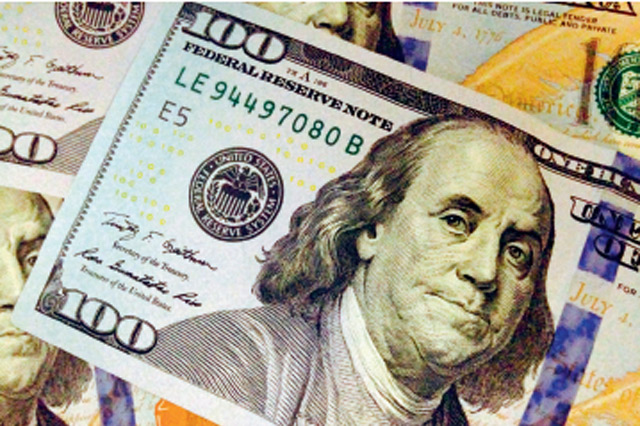
Strong dollar boosts UAE shoppers
Dubai — The continuing strength of the US dollar spells good news for consumers in the UAE. The dirham’s peg to the US currency means that UAE consumers can reap a host of benefits in their purchases of imported goods an expert has informed.
Jameel Ahmad chief market analyst at Cyprus-based ForexTime said that American imports such as cars electronics and luxury brands have become more expensive in countries whose currencies have weakened against the dollar such as Europe Canada and Australia.
In the UAE however the prices of American goods have remained at the same price levels making them no less accessible to the consumer public than before.
In an exclusive interview with Khaleej Times Ahmad noted that European and Japanese imports have become cheaper in the UAE just as they have in the US. With the value of the dirham rising along with the greenback against both the euro and the yen any imports from the European Union (EU) or Japan now cost less.
Expats from Europe the UK India and other countries with weakening currencies against the US dollar are also benefitting from the dirham’s peg to the greenback. The strong dirham exchange rate against most other currencies means that foreign workers in the UAE can now send more money back home.
Data from the International Monetary Fund (IMF) revealed the dollar’s share rising from 62.4 per cent in the third quarter of 2014 to 62.9 per cent by the end of the fourth quarter. The IMF’s report on the currency composition of official foreign exchange reserves saw the euro’s share of currency reserves fall from 22.6 per cent to 22.2 per cent for the final three months of 2014.
On a year-by-year basis reserve holdings in euros declined by 11 per cent and the gap in reserves held in the world’s two biggest currencies is expected to widen when the next Cofer data are published in June. The euro fell six per cent against the US dollar in January falling from 1.2069 at the beginning of the month to 1.1096 by the end of the month.
Ahmad believes that the US dollar will continue its strong performance. “The trend is going to continue with the dollar. It has gotten to the point where the US Central Bank can consider raising interest rates before the majority of the central banks can even begin contemplating the idea. I see the dollar remain strong as long as there is optimism that the Federal Reserve will raise interest rates this year.”
Ahmad expects the US Federal Reserve to start raising interest rates in September. He is not concerned that recent US data has been weaker at the turn of the year. “Spectators need to remember that this is coming on the back of a time where the US has been posting phenomenal growth which is exceeding all expectations and it would have been ambitious at best to expect the US economy to keep growing at five per cent.”
“In the shorter term the dirham might weaken slightly as traders get impatient towards the dollar. However all current indications still point to the US Federal Reserve raising interest rates way before anybody else can even begin considering the idea. It is because of this that traders are going to continue looking towards the dollar” Ahmad noted.
“I still see potential for the dirham to continue its strength against the euro in the same way as I see the dollar maintaining its strength against the euro. This is going to benefit expatriates living in the UAE. This is a good time for citizens in the UAE who have always thought about going on vacation to Europe or about owning a home abroad” he added.
Asked about the Organisation of Petroleum Exporting Countries’ (Opec) decision to not cut oil production Ahmad said he was “not too surprised” that the Opec refrained from cutting production.
“One thing people need to remember is that the economic conditions have changed for oil. The Opec used to be completely in control of the market but now the Opec’s production is only 30 per cent of the global supply. Even if they were to cut production it would just limit their market share and it would put them under intense pressure to continue cutting production in the future. What the situation has confirmed is a very bearish outlook for oil.”
Speaking on the easing of sanctions against Iran Ahmad said: “We live in a world of internationalisation and any economic sanctions being lifted or eased are good for global prospects. In relation to the crude oil prices there is already an aggressive oversupply in the markets of at least two million barrels a day and it is widely reported that sanctions being eased in Iran will add another one million barrels of oil to the market which basically means that it would further the oversupply by a third. I can see this as inspiring some bearish momentum in the price of oil.”
If sanctions are eased then there is no reason to believe that Iran will not boost its output. However Ahmad noted that it will be a gradual process.
According to BP Iran’s proven oil reserves of 160 billion barrels — almost 10 per cent of the world — rank it fourth after Venezuela (300 billion) Saudi Arabia (265 billion) and Canada (175 billion). Experts estimate that the first phase of Iran’s return to global oil markets is most likely to occur in 2016 and 2017 with larger increases in production and exports unlikely to occur before 2018 or 2020.
—

Legal Disclaimer:
MENAFN provides the
information “as is” without warranty of any kind. We do not accept
any responsibility or liability for the accuracy, content, images,
videos, licenses, completeness, legality, or reliability of the information
contained in this article. If you have any complaints or copyright
issues related to this article, kindly contact the provider above.


















Comments
No comment